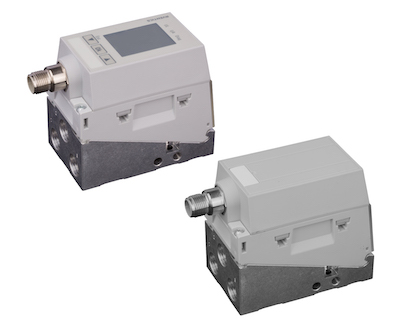The sub-base mounted EV03 electropneumatic (E/P) pressure regulating valve from Aventics features extremely low energy consumption and can guarantee pressure control during a power loss. Depending on the version, maximum power generation is between 160 to 220 mA. The EV03 also offers precision, with hysteresis as low as 0.7 psi, and flow up to 0.88 Cv (880 lpm) at 10 bar of pressure. The EV03 is available in models with an LCD display, or only LED indication. Configurable with the LCD display are: pressure range, regulator behavior, actual value output, or switch output control.
 The Aventics EV03 E/P valves are externally piloted and operate via a poppet valve design for fast, reliable response and have pressure ranges from 0 to 145 psi (1 to 10 bar). The electrical connection is an M12, 5-pin A-coded connector, and electrical protection is IP65. Operating voltage is 24 Vdc. Standard output values are 0 to 10 V or 4 to 20 mA. The compact design has a sub-base with G1/4 connections for input and output, and G1/8 for exhaust.
The Aventics EV03 E/P valves are externally piloted and operate via a poppet valve design for fast, reliable response and have pressure ranges from 0 to 145 psi (1 to 10 bar). The electrical connection is an M12, 5-pin A-coded connector, and electrical protection is IP65. Operating voltage is 24 Vdc. Standard output values are 0 to 10 V or 4 to 20 mA. The compact design has a sub-base with G1/4 connections for input and output, and G1/8 for exhaust.
Electro-pneumatic pressure regulating valves deliver precise and proportional pressure control relative to an electrical signal, acting as electrically operated pressure regulators. They can control pneumatic actuators, cylinders, brakes, clutches and other control functions across a range of industries. Classic examples include precise positioning of parts and components, variable control of welding tips, weight-dependent balancer/dancer technology, and exact controlling/metering in cutting-edge painting systems.
Aventics
www.aventics.com/us
Filed Under: Pneumatic Tips